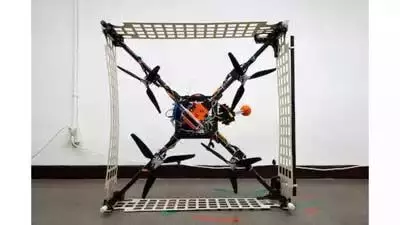South Korean team demonstrated drone
South Korean researchers have developed a transportation drone flying on multiple flexible rotors that corrects itself to stay level in flight and used as a “flying shopping cart” to carry goods over uneven terrain such as stairs May go. The prototype developed by the team at Seoul National University of Science and Technology features a cargo platform mounted on top of a multi-rotor drone and is controlled by a person using light force to guide the hovering aircraft.
Team members demonstrated the hovering platform that has a handle bar like a push shopping cart that carries items up and down stairs and loads boxes on top as it hovers in mid-air and a mass estimation algorithm. Maintains its balance by using the center of gravity. When the wheeled cart can't move objects over uneven terrain or up stairs, the drone responds with human control using what developers call a physical human-robot interaction technology that anticipates human intentions for smooth flight, not mechanical said Lee Seung-jae, professor of systems design engineering.
But the broader focus of Lee's team is not on developing shopping carts used on stairs, but on applications that would use drones with reliable horizontal stability without any tilting and rolling. “The Paletron could be much more than a flying shopping cart,” he said, referring to the name the team gave the prototype by combining the words pallet, which is the platform for cargo on top, and drone. Li's team has tested a platform to carry objects up to 3 kilograms (6.6 lb), and acknowledged that there is commercial potential for cargo transport at such a low weight that humans can easily carry it. Applications are limited.
Still, the mechanism that allows drones to change direction in flight without banking and maintain a level attitude has applications for delivering sensitive or fragile payloads, Lee said. But Li's team is looking ahead to the potential use of the technology for driverless “flying taxis” carrying humans, and for “refueling” drones in the air, by changing batteries so the aircraft can return to base for a fresh charge. There is no need to return.
Multi-rotor drones are inherently limited in speed and range compared to fixed-wing drones, but have better control and maneuverability, including the ability to hover in flight. They have been used to deliver cargo, food, and medical supplies, but commercial applications have been largely limited because it is impractical to increase the size of batteries enough to transport heavy payloads over great distances. Seoul Tech's work was published this year in Robotics and Automation Letters, a publication of the New York-based Institute of Electrical and Electronics Engineers.


Comments are closed.